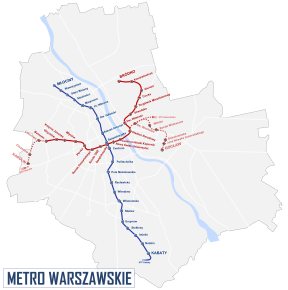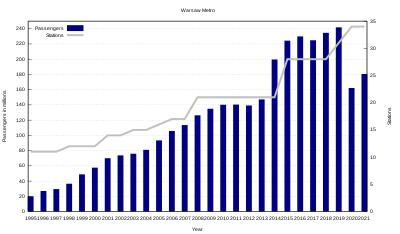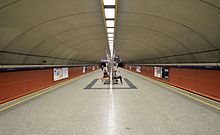Warsaw Metro
| Basic data | |
| Country | Poland |
|---|---|
| city | Warsaw |
| Transport network | ZTM |
| opening | 1995 |
| Lines | 2 (+ 1 in planning) |
| Route length | 32.4 km |
| Stations | 34 |
| Tunnel stations | 34 |
| use | |
| Passengers | 140.4 million per year (2011) |
| vehicles | 81 , Metropolis and Inspiro |
| operator | Metro Warszawskie sp. z o. o. |
| Gauge | 1435 mm ( standard gauge ) |
| Power system | 825 V direct current via side. Busbar |
The Warsaw Metro ( Polish Metro Warszawskie ) is the name of the metro system in the Polish capital Warsaw . The metro, together with the tram and the city bus lines, form the city's local public transport . It was opened in 1995 and currently comprises two lines with a length of 32.4 kilometers and 31 stations. The means of transport is operated by the transport company Metro Warszawskie Sp. Z oo (German: Warsaw Metro GmbH).
Route network
Lines and operations
There are currently two underground lines running entirely in tunnels in Warsaw: M1 and M2.
M1 Kabaty - Młociny
The M1 line, which has been designated since 2015, is the first line of the Warsaw Metro with a length of 23.1 km and 21 stations (starting from the south): Kabaty - Natolin - Imielin - Stokłosy - Ursynów - Służew - Wilanowska - Wierzbno - Racławicka - Pole Mokotowskie - Politechnika ( Technical University ) - Centrum ( city center ) - Świętokrzyska - Ratusz Arsenał ( City Hall Armory ) - Dworzec Gdański ( Gdańsk Railway Station ) - Plac Wilsona - Marymont - Słodowiec - Stare Bielany - Wawrzyszew - Młociny . It connects the southern districts of the left bank of the Vistula Ursynów and Mokotów via the city center with the northern districts of Żoliborz and Bielany.
The trains on Warsaw's first metro line run Monday through Thursday and Sunday between 5 a.m. and midnight. On Fridays and Saturdays, the Warsaw Metro runs between 5 a.m. and 3 a.m. During rush hour , every 2½ to 3 minutes, during off- peak hours every 6 to 10 minutes and from midnight every 15 minutes. An average of around 280,000 to 500,000 passengers are transported per day.
M2 Księcia Janusza - Trocka
Line M2 with a length of approx. 12.6 km and thirteen stations (starting from the west): Księcia Janusza - Młynów - Płocka - Rondo Daszyńskiego - Rondo ONZ ( UNO roundabout ) - Świętokrzyska - Nowy Świat-Uniwersytet ( University ) - Centrum Nauki Kopernik ( Copernicus Science Center ) - Narodowy Stadium ( National Stadium ) - Dworzec Wileński (Vilnius Railway Station) - Szwedzka - Targówek Mieszkaniowy - Trocka crosses under the Vistula. It runs from the western Wola district through the city center to the Praga-Północ and Targówek districts , which are located on the right bank of the river.
The second line runs Mondays to Thursdays and Sundays between 5 a.m. and 12:40 a.m., Fridays and Saturdays until 3 a.m., every 3 minutes during rush hour, every 5 to 8 minutes during off-peak hours and every 15 minutes from midnight.
Tariff association
The Warsaw Metro is part of the diverse local public transport system in Warsaw. In addition to the metro, this also includes the tram, which opened in 1866, and an extensive bus network. The local railway WKD, which opened in 1925, takes on more regional than local tasks, as does the suburban trains of the regional railway company Koleje Mazowieckie . There is a tariff association ( wspólny bilet ) between urban and regional means of transport within the city and in the surrounding area.
Passenger numbers
Since 1995 the Warsaw Metro has carried more than 600 million passengers; so far, the number of passengers has risen steadily in recent years. More and more Warsaw residents are using local public transport, especially due to the extension of the metro and the development of the city center. While 76 million passengers still used the metro in 2003, in 2004 it was already 80.9 and in 2005 - after the opening of the Plac Wilsona station - already 93.4 million passengers. A further constant increase in the number of passengers is expected with the full expansion of Line 1 and the construction of Line 2.
At the top of the most popular stations is the Centrum station , which was used by 13.25 million passengers in 2005; As you can see from its name, the underground station is located in the center of the Polish capital, and the Warsaw Central Station is also nearby. The Ratusz Arsenał underground station is just as well frequented with 8.41 million passengers in 2005, also in an inner-city location, and the Warsaw City Hall is also located - as can be seen from the name. The Politechnika train station is also part of it, which was used by 8.45 million passengers in 2005. The stations with few users compared to the most visited stations are Racławicka (3.60 million), Ursynów (3.72 million) and Wierzbno (3.77 million).
architecture
All metro stations are each equipped with at least two elevators and, with the exception of the Centrum and the four northernmost stations on the M1 line Słodowiec , Stare Bielany , Wawrzyszew and Młociny , all have central platforms . The platforms are 120 meters long (platform on line M2 at Świętokrzyska station even 127 m) and are therefore designed for six-car trains. The width of the platform is between 10 and 15 meters, depending on the importance of the station. Two stations each have two central platforms and four tracks: Świętokrzyska consists of two L-shaped platforms for the two existing lines, while the Narodowy Stadium is parallel to the M2 platform and another as a preliminary construction work for the planned third line.
In the run-up to the opening of the metro, between 1982 and 1985, the architects Jasna Strzałkowska-Ryszka , Lech Kłosiewicz , Andrzej Pańkowski and Jerzy Blancard designed a concept for the first Polish metro. According to their principle, an underground station consists of the public part, the station area and the non-public part. The public part is the area used, among other things, as a pedestrian underpass, which can be entered at any time and at no cost. The station area, on the other hand, is only accessible during the opening times of the metro. This is where the passengers stay and that is where the platforms are. The non-public part is only accessible to employees and consists of technical systems. Each area is separated from each other by visual barriers, partly glass, partly steel.
In the meantime, the group of architects also designed a color concept based on the (then) urban districts that were tangent to the metro. In the southern area, for example, the M1 primarily passes through the Mokotów district , whose stations are colored brown; This is followed by the then district Centrum , today Śródmieście (Polish city center ), in whose stations the color green is to dominate; in the north, in the Bielany district , the train stations should be marked with the color blue.
Furthermore, the group of architects established additional, generally applicable design and layout rules for the train stations. This includes brightly lit platforms, in contrast to the darkened tracks, as well as an open and friendly interior design through clearly visible ceilings. Blue, which is also used as a line color, and red and white, the two colors of the Polish national flag , have been selected as the three basic colors of the Warsaw subway's corporate design . These three colors are used consistently in all areas open to the public.
During the northern expansion of the first line (M1) at the beginning of the 21st century, the original concept was abandoned and the new underground stations were given an individual design. The Dworzec Gdański stop, opened in 2003, was designed by Stefan Kuryłowicz . The Plac Wilsona stop , for which Andrzej Chołdzyński was in charge, was voted the most beautiful stop in the world by MetroRail in April 2008. The same architect, in collaboration with Wojciech Fangor, also designed all seven stations of the first section of the second line (M2). The planning for the Ratusz Arsenał , Marymont , Słodowiec and Bielany stations on the M1 line was drawn up by the architects AiB.
history
First plans and failed attempts
As early as the 1920s, construction of a subway began in Warsaw , and several studies were undertaken in 1925, 1927 and 1938. However, due to the Second World War , construction stalled and was abandoned. After the Second World War, the city administration decided to build the subway again, and the first test drillings were carried out in 1951. In 1953, the city administration also had an 800-meter-long, very deep tunnel excavated; the project was abandoned again due to the economic and geological difficulties of the Warsaw underground (sandy soils and drained swamps with high groundwater levels ). The tunnel structure remains unused.
Construction of the first line
In 1962 the Warsaw city administration had the subway project reissued and completely redesigned. First, a north-south route was to be built, this time in flat tunnels. However, it was only twenty years later, in December 1982, that the Polish government decided by decree No. 266/82 to resume construction work. A treaty was signed with the Soviet Union, which was primarily intended to regulate technical cooperation between the two states. The resumption of construction work - it began on April 15, 1983 - also resulted in some rescheduling of the future subway network. However, the economic situation in Poland deteriorated in the 1980s, so that the work was delayed. Due to financial problems, it was decided in 1989 to do without the stations Pl. Konstytucji and Muranów for the time being .
Only years after the collapse of the Soviet Union , on April 7, 1995, could the operation of the first Polish subway between the Kabaty and Politechnika stations go into operation. The first stretch, 11½ kilometers long, ran completely in the tunnel from the south of the city towards the center. Except for the last few hundred meters at what was then the northern end, the construction work was carried out entirely using the open construction method, which means that the streets al. Niepodległości and al. Komisji Edukacji Narodowej were closed to city traffic for several years. The following sections below Warsaw's city center were built from now on using hand shield driving . Three years later, on May 26, 1998, another section, the 1½-kilometer-long underground tunnel from Politechnika to Centrum , was put into operation, with the Centrum station also connecting Warsaw's main train station. The Plac Konstytucji station is planned between these stations , which will act as a transfer station for a planned subway line 3.
The third stage which went into operation on 11 May 2001 route between the Warsaw Central Station (applies Centrum ) and Town Hall ( Ratusz ), it is 1.7 km long. In the following years the openings took place gradually. Since April 8, 2005 the trains have been running to Plac Wilsona , since December 29, 2006 to Marymont and since April 23, 2008 to Słodowiec . On October 25, 2008, the last section of the M1 line, 3.6 kilometers in length, was again built using the cut-and-cover method in the Bielany district under al. Jana Kasprowicza put into operation.
Construction of the second line
The second line, which according to the original plan was to start in the north at the Dąbrówka station, should first follow the course of the Vistula , then cross the route of the Polish State Railway ( PKP) twice , then cross under the Vistula, cross the M1 line and then finally to the west end at Chrzanów station. In May 2006, the application for the granting of the building permit for line 2, in the area Rondo Daszyńskiego - Dworzec Wileński (Vilnius station) with seven stations, was made. Construction began on August 16, 2010. The two separate directional tunnels and the connecting curve to the M1 line required for operational purposes were built using a total of four tunnel boring machines . The train stations and the ventilation / smoke extraction centers were built using the open construction method, which is why it was necessary to block some streets in the city center. During the construction of the crossing structure with the road tunnel in the area of the Centrum Nauki Kopernik train station , there was extensive water ingress, which is why construction was delayed. Most of the construction work was completed in August 2014; the start of test operations on the 6½-kilometer section was scheduled for September 30, 2014. After several postponements, the first section of the second metro line, now called M2, between Rondo Daszyńskiego and the Vilnius train station ( Dworzec Wileński ) opened on March 8, 2015.
Construction projects and planning
In the Warsaw city administration there are plans for the extension of the second subway line and for another subway line, which will complement the inner-city local transport network in addition to buses, trams, the WKD light rail line and the suburban trains of the Polish State Railways PKP.
The second line is to be extended to Chrzanów in the west in three construction phases , but only to Bródno in the northeast . Initially, around 3.4 km of route with three stations to the west and at the same time around 3.12 km of route with three stations to the northeast, each with sidings behind the provisional terminus, are to be built by 2019. The tendering phase for the selection of the general contractor for the two construction lots should be completed in 2015.
The third line - or planned as a branch of the M2 line in the first phase - is to begin at Stadion Narodowy underground station and continue in a south-easterly direction to Wilga station . Originally it was planned to continue the route from the stadium to the southwest in order to cross the first line at Plac Konstytucji and to find its final end at Dworzec Zachodni (West Railway Station). No dates have yet been set for this route. A fourth subway line, which was planned for a time, is no longer included in the plans.
vehicles
The Warsaw Metro currently has three types of train: First, the 81 series trains built by the former Soviet company Metrowagonmasch at the end of the 1980s, secondly the Metropolis series wagons from the French company Alstom, which have been delivered since 2000, and thirdly, the Inspiro series wagons delivered since 2014 . All carriages receive their traction current via a third, laterally attached busbar , the traction voltage is 825 volts direct current according to the usual Soviet standard. All cars are serviced in the depot near Kabaty train station .
| line | Manufacturer (model) | image | Installation | number | dare | Length (m) | Seats | capacity |
|---|---|---|---|---|---|---|---|---|
| M1 |
Metrowagonmash ( 81-717.3 / 714.3 ) |
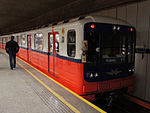
|
1990 | 10 | 6th | 115.4 | 260 | 1200 |
| M1 |
Metrowagonmash ( 81-572 / 573 ) |

|
1994-1997 | 50 | 6th | 115.4 | 260 | 1200 |
| M1 |
Metrowagonmash ( 81-572.2 / 573.2 ) |
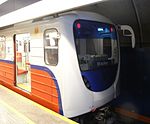
|
2009 | 6th | 115.4 | 260 | 1200 | |
| M1 |
Alstom ( Alstom Metropolis ) |
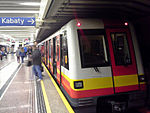
|
2000-2005 | 18th | 6th | 117.1 | 264 | 1454 |
| M1 |
Siemens Mobility ( Siemens Inspiro ) |

|
2013 | 35 | 6th | 117.7 | 232 | 1500 |
| M2 |
81 series
In the agreement between Poland and the Soviet Union of 1982/1983, in addition to technical assistance, the delivery of vehicles from the Metrowagonmasch company was agreed. The first ten trains of the class 81-717.3 (with driver's cab) and 81-714.3 (without driver's cab), which were also delivered in other former socialist countries such as the Czech Republic and Bulgaria , were handed over to Poland in June 1990 by the USSR however, discontinued as the financial and economic problems of the Soviet Union worsened. In the run-up to the opening of the metro in 1995, Poland bought 32 more trains of the improved type 81-572P / 573P . The Warsaw Metro currently has 60 trains of the 81 series. A single wagon made of steel parts is 2.71 meters wide and 19.21 meters long. There are four doors on each side, these are 1.2 meters wide. The maximum speed is limited to 90 km / h , but the average cruising speed is 36 km / h; one car can carry 200 people.
Metropolis series
In order to offer the passengers better comfort and to achieve a lower maintenance frequency of the trains, the operating company of the Warsaw Metro announced a competition for the new development of a series. In August 1998, the French rail vehicle manufacturer Alstom was selected. The first vehicles, which were mainly built in Spain and Poland, have been in use since October 2000. In a total of four deliveries - four full trains each in 2000 and 2001 and five full trains each in 2002 and 2004 - Alstom delivered a total of 18 full trains made primarily of aluminum or 108 single wagons; six individual wagons make up one implementation. A train is 117 meters long, 2.72 meters wide and can travel up to 90 km / h. The space for a prison encompasses 264 seats and 1206 standing places (with six people per m²). Unfortunately, the wheels showed signs of wear very quickly and often had to be sharpened.
Inspiro series
In January 2011, the operating company awarded the order for a new series of subway cars to a consortium of Siemens AG and the Polish Newag SA . A total of 35 six-car trains from the Inspiro series have been ordered. The trains are to be delivered from autumn 2012. 15 of the trains are to be used on the existing M1 line and the 20 other trains on the new M2 line. An option for 17 additional trains was also agreed. The first ten units will be completely built in the Siemens plant in Vienna - Simmering , while the other trains are to be assembled at Newag in Nowy Sącz . The first trains have been in operation since October 6, 2013. On November 17, 2013, there was a fire in the chassis of a wagon, all trains were temporarily withdrawn from traffic, but are now back in service (January 2015).
Call 2017
In October 2017, the offers of a tender for 37 seven-part vehicles (plus an option for a further eight trains) consisting of 74 multiple units and 148 intermediate cars were opened. The cheapest offer came from a consortium consisting of Škoda Transportation and Škoda Vagonka, which submitted a gross bid of 1.608 billion zlotys. The only other offer within the 1.69 billion zloty budget came from Stadler Poland, which offered a gross price of 1.656 billion zlotys. The remaining three offers from Alstom Konstal, CAF and a consortium of Siemens Poland, Siemens Austria and Newag ranged from 1.7 billion to 2.2 billion zlotys.
Kabaty workshop
All trains and other construction and work vehicles are serviced in the operations workshop near the Kabaty station. The 30 hectare site has ten halls for smaller work, such as graffiti removal and glass replacement, as well as two halls for the statutory general inspections. In addition to a 1.2-kilometer test track, for example for new vehicles, the workshop also has a rail connection to the Polish state railway PKP.
literature
- WJ Hinkel, K.reiber, G. Valenta and H. Liebsch: U-Bahns yesterday - today - tomorrow from 1863 to 2010 , Schmid-Verlag, Vienna 2004, ISBN 3-900607-44-3 (chapter Warsaw)
- Robert Schwandl: Tram Atlas Poland Poland . 1st edition. Robert Schwandl Verlag, Berlin 2017, ISBN 978-3-936573-50-3 , pp. 122-131 , chapter Warszawa (German, English).
Web links
- Metro operator site (Polish, English)
- Warsaw Transport Authority (Polish)
- Warsaw Metro Fan Page (Polish)
- The Warsaw subway at urbanrail.net (English)
- Image page for the Warsaw Metro (German, English) on public-transport.net
Individual evidence
- ↑ Metro Warszawskie, Raport roczny 2011 , p. 36 ( PDF file ( Memento of the original from March 10, 2013 in the Internet Archive ) Info: The archive link has been inserted automatically and has not yet been checked. Please check the original and archive link according to the instructions and remove then this note. )
- ↑ a b c Verkehrsverbund ZTM: Metro timetables
- ↑ Data on the metro operation, homepage of the operating company ( Memento of the original from January 17, 2007 in the Internet Archive ) Info: The archive link was inserted automatically and has not yet been checked. Please check the original and archive link according to the instructions and then remove this notice.
- ↑ a b Annual report 2005 of the operating company (PDF; 6.23 MB) ( page no longer available , search in web archives ) Info: The link was automatically marked as defective. Please check the link according to the instructions and then remove this notice.
- ↑ Metro Warszawskie: II linia mtra "Świętokrzyska" ( Memento of the original from March 14, 2015 in the Internet Archive ) Info: The archive link was automatically inserted and not yet checked. Please check the original and archive link according to the instructions and then remove this notice.
- ^ APA Kuryłowicz & Associates: Stacja Metra - Dworzec Gdański
- ^ AiB: Infrastruktura transportowa
- ^ Urbanowicz, Witold: Historia warszawskiego metra (Polish).
- ↑ Wielka chwila: ruszają prace przy drugiej linii metra
- ^ Keith Barrow: Warsaw metro Line 2 nears completion. On: www.railjournal.com, August 29, 2014
- ↑ Nov-Ost-Info (March 8, 2015): Metro line II opened in Warsaw
- ↑ Internet portal of the capital Warsaw: Ruszył przetarg na rozbudowę metra (Polish)
- ↑ Information on the 81-572P / 81-573P series, homepage of the operating company ( Memento of the original from October 7, 2006 in the Internet Archive ) Info: The archive link was inserted automatically and has not yet been checked. Please check the original and archive link according to the instructions and then remove this notice.
- ↑ Information on the Warsaw variant of the Metropolis series, Alstom homepage
- ↑ Information on the Warsaw variant of the Metropolis series, homepage of the operating company ( Memento of the original from October 7, 2006 in the Internet Archive ) Info: The archive link was inserted automatically and has not yet been checked. Please check the original and archive link according to the instructions and then remove this notice.
- ↑ IRJ, October 24, 2017: Five suppliers bid for Warsaw metro train contract


